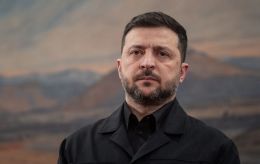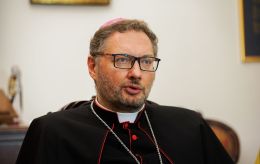Russia's successes in western Donetsk region do not mean collapse of frontline for Ukrainian army - ISW
 Russians are advancing in the Donetsk region, but this does not mean complete success (Illustrative photo: Getty Images)
Russians are advancing in the Donetsk region, but this does not mean complete success (Illustrative photo: Getty Images)
Russia's advance in the western Donetsk region could become operationally significant only if the Russian command effectively exploits its recent tactical successes, which is not a guaranteed development, reports the Institute for the Study of War (ISW).
The report notes that Russian offensive actions in western Donetsk do not automatically signal the collapse of the Ukrainian front.
Recent mechanized attacks by Russian forces, involving airborne assault troops (VDV), northeast of Vuhledar, appear to align with mechanized assaults by the Eastern Military District (EMD) near Velyka Novosilka. This further corroborates the ISW's assessment that EMD and VDV units are currently conducting joint offensive operations in this sector of western Donetsk.
The Institute is convinced that the ability of Russian forces to advance further towards the borders of Zaporizhzhia and Dnipropetrovsk regions will largely depend on whether the commanders of the Russian Eastern and Southern Military Districts continue to successfully coordinate combat operations along their respective fronts.
The report also states that even if Russian forces managed to achieve all the aforementioned operational objectives, they would still need to capture over 8,000 km² of territory to accomplish Moscow's declared goal of seizing the entire Donetsk region.
Potential Russian advances southeast into Dnipropetrovsk, considering historical data on Russian offensives, are unlikely to be rapid and will not pose a threat to central Ukrainian military assets or major cities during the winter campaign of 2024-2025.
"The Ukrainian theater is large and Russian tactical gains in western Donetsk Oblast should not cause undue panic in the short-term. Russian gains remain tactical and Russian forces have not restored operational maneuver to the battlefield yet. The current Russian advances may fall short of their operational objectives, as did initial Russian frontal assaults against Chasiv Yar and Pokrovsk earlier in 2024," ISW analysts note.
Threat of encirclement of Velyka Novosilka
The ISW noted that Russian forces continue to make significant tactical gains in western Donetsk, approaching the encirclement of Velyka Novosilka and advancing towards key Ukrainian ground communication lines that connect the western part of Donetsk with the eastern regions of Dnipropetrovsk and Zaporizhzhia.
Geolocation images published on November 24 show units of Russia's 5th Tank Brigade (36th CAA, Eastern Military District [EMD]) advancing towards the eastern outskirts of Velyka Novosilka, east of the Donetsk-Zaporizhzhia border.
Several Russian military bloggers claim that Russian forces have also advanced to the northeast and southeast of Velyka Novosilka. According to reports, Russian units of the Eastern Military District, particularly the 2nd Battalion of the 37th Motorized Rifle Brigade (36th CAA, EMD), are pushing towards the outskirts of Velyka Novosilka.
Occupation of Kurakhove and neighboring villages
Russian forces continue efforts to eliminate a small position east of the O0510 Kurakhove-Velyka Novosilka road (southeast of Kurakhove and northeast of Vuhledar). Geolocation footage published on November 25 indicates that units of Russia's 5th Motorized Rifle Brigade (51st Combined Arms Army [CAA], formerly 1st Donetsk People's Republic Army Corps [DNR AC] have advanced to Pobiedy Street in central Kurakhove.
Several Russian military bloggers reported on November 25 that Russian forces had captured Romanivka (northeast of Vuhledar) and gained additional positions in the fields surrounding the settlement.
The report notes that the ISW has not yet confirmed that Russian forces are operating within Romanivka. However, geolocation images published on November 24 show two separate Russian mechanized platoon attacks east of Romanivka near Illinka and Antonivka, indicating that during these attacks, Russian forces advanced towards Romanivka.
Reports indicate that the mechanized attack near Antonivka was carried out by units of the 33rd Motorized Rifle Regiment (20th Motorized Rifle Division (8th CAA, Southern Military District [SMD]. Russian bloggers note that Russian forces in this area are focused on forcing Ukrainian troops to retreat westward towards Kostyantynopolske (northwest of Vuhledar).
Options for Russia's further actions
Earlier, the ISW assessed that the Russian military command had several potential courses of action on this section of the front. Russian gains on November 24 and 25 align with two of the outlined options: attempts to advance west along the H15 to the Andriivka-Kostyantynopil line from Kurakhove, and efforts to bypass Velyka Novosilka and create a threat to Ukrainian positions in eastern Zaporizhzhia.
"Russian forces have already seized positions along the H15 road in eastern Kurakhove, and will likely use new positions along Pobiedy Street (which runs southward perpendicular to the H15 road) to further interdict and advance westward through Kurakhove and along the H15, towards Dachne and Andriivka (both west of Kurakhove)," the report states.
The recent advance of Russian forces to Pobiedy Street in the center of Kurakhove suggests that Russian troops are now about 15 kilometers east of Andriivka.
Both Russian military bloggers and Ukrainian military analyst Kostyantyn Mashovets have identified Andriivka as a key Russian operational target west of Kurakhove. The occupation of Andriivka would provide Russian forces with a stronger position from which they could target a chain of settlements along the O0510 highway to the northwest and northeast of Vuhledar.
Russian forces may continue their westward push along the H15 highway towards Andriivka, while simultaneously attacking Ukrainian positions to the northeast of Vuhledar along the Uspenivka-Hannivka-Romanivka line, aiming to force Ukrainian troops to retreat westward to avoid encirclement.
"Such a maneuver could enable Russian forces to seize tactical positions in the area and level the frontline from Sontsivka (northwest of Kurakhove) to Kostyantynopolske, placing Russian forces about 23km east of the Donetsk-Dnipropetrovsk Oblast border at its closest point," the Institute for the Study of War notes.

Russian military advances in the Donetsk region
Russian forces continue to rapidly advance in the western part of the Donetsk region, capturing more and more settlements. The enemy has come close to Pokrovsk, while further south, from the already captured Vuhledar, they are moving towards the town of Velyka Novosilka.
The Institute for the Study of War noted that the Russian advance in southeastern Ukraine since the autumn of 2024 is largely due to the identification and tactical exploitation of vulnerabilities in Ukrainian Armed Forces positions.
Recently mobilized Russian troops are settling in homes in the settlements of the Velyka Novosilka district.
Meanwhile, in Velyka Novosilka itself, half of the buildings have been destroyed, and residents are largely staying in basements.

